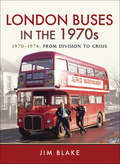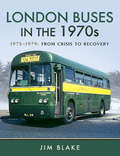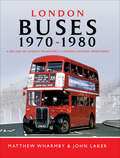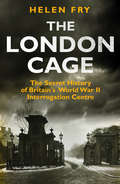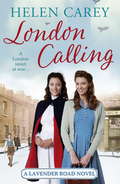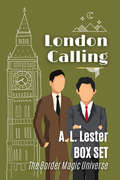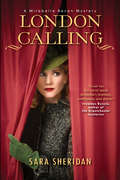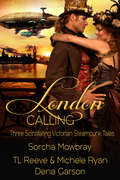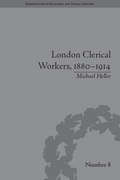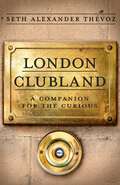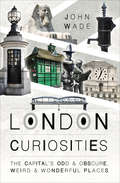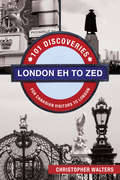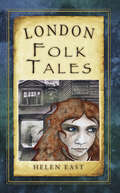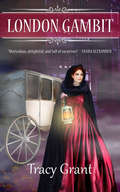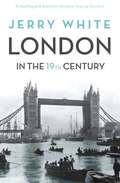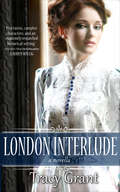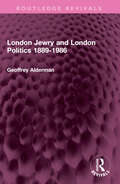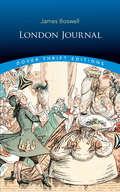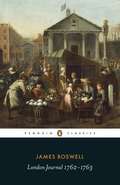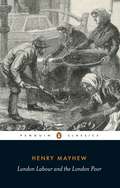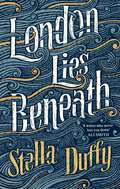- Table View
- List View
London Buses in the 1970s, 1970–1974: From Division to Crisis
by Jim BlakeUsing photographs from Jim Blake's extensive archives, this book examines the turbulent period in the history of London's buses immediately after London Transport lost its Country Buses and Green Line Coaches to the recently-formed National Bus Company, under their new subsidiary company, London Country Bus Services Ltd.The new entity inherited a largely elderly fleet of buses from London Transport, notably almost 500 RT-class AEC Regent double-deckers, of which replacement was already under way in the shape of new AEC MB and SM class Swift single-deckers.London Transport itself was in the throes of replacing a much larger fleet of these. At the time of the split, it was already apparent that the 36ft-long MB class single-deckers were not suitable for London conditions, particularly in negotiating suburban streets cluttered with cars, and were also mechanically unreliable. The shorter SM class superseded them but they were equally unreliable. January 1971 saw the appearance of London Transport's first purpose-built one-man operated double-decker, the DMS class. All manner of problems plagued these, too.Both operators were also plagued with a shortage of spare parts for their vehicles, made worse by the three-day week imposed by the Heath regime in 1973-4. London Transport and London Country were still closely related, with the latter's buses continuing to be overhauled at LT's Aldenham Works. Such were the problems with the MB, SM, and DMS types that LT not only had to resurrect elderly RTs to keep services going, but even repurchased some from London Country! In turn, the latter operator hired a number of MB-types from LT, now abandoned as useless, from 1974 onwards in an effort to cover their own vehicle shortages. Things looked bleak for both operators in the mid-1970s.This book contains a variety of interesting and often unusual photographs illustrating all of this, most of which have never been published before.
London Buses in the 1970s: 1975–1979: From Crisis to Recovery
by Jim Blake&“A compilation of photos taken in the difficult period . . . when LT and London Country were plagued with maintenance problems. A valuable record.&” —West Somerset Railway Association Continuing with images from transport photographer Jim Blake&’s extensive archives, this book examines the second half of the 1970s, when both London Transport and London Country were still struggling to keep services going. This resulted both from being plagued by a shortage of spare parts for their vehicles and having a number of vehicle types which were unreliable—the MB, SM and DMS classes. In 1975, both operators had to hire buses from other companies, so desperate were they. Many came from the seaside towns of Southend, Bournemouth and Eastbourne. This continued until the spares shortage began to abate later in the decade, particularly with London Country. As the decade progressed, the two fleets began to lose their &“ancestral&” vehicle types. London Country rapidly became &“just another National Bus Company fleet,&” buying Leyland Atlanteans and Nationals common to most others throughout the country. Having virtually abandoned the awful MB and SM-types, London Transport had to suffer buying the equally awful DMSs well into 1978, but had already ordered replacements for them by that point—the M class Metrobuses and T class Titans—both of which would finally prove successful. However, plans to convert trunk routes serving Central London to one-person operation were largely abandoned. &“A very interesting book. The passenger transport crisis in London in the mid-1970s was a major event.&” —Miniaturas JM
London Buses, 1970–1980: A Decade of London Transport and London Country Operations
by Matthew WharmbyThe 1970s were among London Transports most troubled years. Prohibited from designing its own buses for the gruelling conditions of the capital, LT was compelled to embark upon mass orders for the broadly standard products of national manufacturers, which for one reason or another proved to be disastrous failures in the capital and were disposed of prematurely at a great loss. Despite a continuing spares shortage combined with industrial action, the old organisation kept going somehow, with the venerable RT and Routemaster families still at the forefront of operations.At the same time, the green buses of the Country Area were taken over by the National Bus Company as London Country Bus Services. Little by little, and not without problems of their own, the mostly elderly but standard inherited buses gave way to a variety of diverted orders, some successful others far from so, until by the end of the decade we could see a mostly NBC-standard fleet of one-man-operated buses in corporate leaf green.
London Cage: The Secret History of Britain's World War II Interrogation Centre
by Helen FryThe first complete account of the fiercely guarded secrets of London’s clandestine interrogation center, operated by the British Secret Service from 1940 to 1948 Behind the locked doors of three mansions in London’s exclusive Kensington Palace Gardens neighborhood, the British Secret Service established a highly secret prison in 1940: the London Cage. Here recalcitrant German prisoners of war were subjected to “special intelligence treatment.” The stakes were high: the war’s outcome could hinge on obtaining information German prisoners were determined to withhold. After the war, high-ranking Nazi war criminals were housed in the Cage, revamped as an important center for investigating German war crimes. This riveting book reveals the full details of operations at the London Cage and subsequent efforts to hide them. Helen Fry’s extraordinary original research uncovers the grim picture of prisoners’ daily lives and of systemic Soviet-style mistreatment. The author also provides sensational evidence to counter official denials concerning the use of “truth drugs” and “enhanced interrogation” techniques. Bringing dark secrets to light, this groundbreaking book at last provides an objective and complete history of the London Cage.
London Calling
by Helen CareyLONDON CALLING is a poignant, warm-hearted and engaging saga of Clapham, south London's women during the Second World War, for readers of Kate Thompson, Annie Murray and Katie Flynn. It will take more than Hitler's Luftwaffe to break the spirit of the residents of Lavender Road. If courage and resilience could win wars, the conflict would already be over.It's not all harmony, though. Nurse Molly Coogan and would-be actress Jen Carter certainly don't see eye to eye. Molly, despite hating the discipline of wartime hospital life, is unimpressed by Jen's prima donna ways. Jen, unaware of Molly's secret heartache, can't resist taking her own frustrations out on Molly. It's just as well that no one knows what challenges lie ahead...From stolen glasses in the Flag and Garter to fancy dinners in the heart of the West End, from a desperate battle for survival on a hospital ward to a torpedo hitting its target in the Mediterranean Sea, LONDON CALLING takes readers into a world of ordinary people living extraordinary lives.
London Calling
by Helen CareyLONDON CALLING is a poignant, warm-hearted and engaging saga of Clapham, south London's women during the Second World War, for readers of Kate Thompson, Annie Murray and Katie Flynn. It will take more than Hitler's Luftwaffe to break the spirit of the residents of Lavender Road. If courage and resilience could win wars, the conflict would already be over.It's not all harmony, though. Nurse Molly Coogan and would-be actress Jen Carter certainly don't see eye to eye. Molly, despite hating the discipline of wartime hospital life, is unimpressed by Jen's prima donna ways. Jen, unaware of Molly's secret heartache, can't resist taking her own frustrations out on Molly. It's just as well that no one knows what challenges lie ahead...From stolen glasses in the Flag and Garter to fancy dinners in the heart of the West End, from a desperate battle for survival on a hospital ward to a torpedo hitting its target in the Mediterranean Sea, LONDON CALLING takes readers into a world of ordinary people living extraordinary lives.
London Calling Box Set
by A. L. LesterQueer British Lovecraftian historical romantic suspense set in 1920s London.Lew Tyler is dragged from 2016 to 1920 by an accident with border magic whilst he’s searching for his missing friend. He’s struggling to get to grips with life a century before he was born. Detective Alec Carter is trying to solve gruesome murders in his patch of London, weighed down with exhaustion and a jaded attitude to most of his fellow humans after four years of war. In the middle of a murder investigation that involves wild magic, mysterious creatures and illegal sexual desire, will Alec and Lew work out who is safe to trust?Sergeant Will Grant, Alec’s right-hand man, is drawn to the mysterious Fenn. Is Fenn a man or a woman? Does Will care? And Fenn ... Fenn has a secret. They live beyond the border between 1920s London and the magical Outlands and they need to get home. Are they prepared to achieve that by double crossing Alec, Will, and Lew?Two couples hold the fabric of reality in their hands. Will it make them or break them? Contains the stories:Lost in Time: Gruesome murders taking place across 1920s London draw Lew and Alec together through the desolation of the East End and the smoky music clubs of Soho. They both have secrets that could get them arrested or killed. In the middle of a murder investigation that involves wild magic, mysterious creatures and illegal sexual desire, who is safe to trust?Shadows on the Border: In 1920s London, Lew and his lover Detective Alec Carter are working out the parameters of their new relationship. Lew is torn between staying in the past and trying to get back to 2016. Alec is wrestling with the idea both of being in love and Lew being a magician. Meanwhile Alec’s sergeant, Will Grant, is drawn to the mysterious Fenn, a hunter from the Outlands.The Hunted and the Hind: Inadvertently tumbling through the border after Fenn, Sergeant Will Grant of the Metropolitan Police has spent three months in prison. When Fenn frees him, they step through the border to the Egyptian desert. It’s a two week trip back to England, with the possibility of pursuit. Will the journey give Fenn and Will time to resolve the feelings they have been dancing around since the day they met?
London Calling: A Mirabelle Bevan Mystery (A Mirabelle Bevan Mystery #2)
by Sara SheridanIn the years following World War II, former Secret Service employee Mirabelle Bevan has found a refuge in the quiet coastal town of Brighton. But she can’t seem to resist an attraction to danger and a thirst for justice . . .1952: Eighteen-year-old debutante Rose Bellamy Gore was last seen outside a Soho jazz club in the company of a saxophone player named Lindon Claremont. Now her mysterious disappearance is front-page news in the London tabloids.When Lindon turns up the next day in Brighton, desperately seeking help, Mirabelle counsels him to cooperate with the authorities. After the local police take the musician into custody and ship him off to Scotland Yard, Mirabelle and her best friend, Vesta Churchill, hop a train to London in search of the truth.As they scour smoky jazz clubs searching for clues to the deb’s disappearance, they descend into a sinister underworld where the price of admission can be one’s life. Mirabelle will need to draw on her espionage skills to improvise her way out of a disappearing act of her own . . .Praise for the first Mirabelle Bevan mystery, Brighton Belle“Beneath that prim exterior lies a fearless, fly-by-the-seat-of-her-pants kind of gal. One part Nancy Drew, two parts Jessica Fletcher, Mirabelle has a dogged tenacity to rival Poirot.” —Sunday Herald“Unfailingly stylish, undeniably smart.” —Daily Record“I was gripped from start to finish.” —Newbooks“Fresh, exciting, and darkly plotted, this sharp historical mystery plunges the reader into a shadowy and forgotten past.” —Good Book Guide“Early 1950s England is effectively portrayed in this intriguing mystery story . . . An excellent read for the beach or a long flight.” —Historical Novel Review“After many twists and turns, she finally unravels the mystery in an entertaining romp pitting her wits against underworld characters and scheming impostors.” —Bookseller“An entertaining mystery read—light, intriguing and ideal for a weekend escape. Bits of history enhance the plot without overwhelming it, and a handful of unexpected twists keep the reader guessing.” —RT Book Reviews
London Calling: Three Scintillating Victorian Steampunk Tales
by Tl Reeve Michele Ryan Sorcha Mowbray Dena GarsonJourney to Victorian London where an assassin meets her match, zombies invade, and top scientists go missing.Four talented authors come together to bring you three BRAND NEW, full length Victorian steampunk novels of seduction, adventure, and mystery. A look inside…Seducing the Assassin (Book 1, The Ladies League)by Sorcha MowbrayJosephine Stanton, Madame and assassin, has another assignment to eliminate an enemy of the Queen. Too bad John Griffin, The Earl of Melton, has no intention of dying. Neither of the pair expects the heat that steams them up between the sheets and ultimately sets New Victorian London on its ear. Darkness Rises by TL Reeve and Michele RyanA zombie horde has invaded London, England. Jonah McRae and his band of ghoulish Dreadfuls are London’s only hope. However, when Annabelle Craig threatens his mission he doesn’t know whether to kill her or claim her as his. Can the hunter and the huntee team together to take down the horde? Or will London be lost forever? Her Clockwork Heart by Dena GarsonDuring her search for her missing brother, Trixie is reunited with Nathaniel, the man she never stopped loving. Sensing that Trixie might be in danger, Nathaniel lends his skills as an investigator to her efforts. Their love is rekindled as they race across the country looking for clues to more than one mystery.
London Clerical Workers, 1880–1914: Development of the Labour Market (Perspectives in Economic and Social History #8)
by Michael HellerThis study is based on a wide range of business sources as well as newspapers, journals, novels and oral history, allowing Heller to put forward a new interpretation of working conditions for London clerks, highlighting the ways in which clerical work changed and modernized over this period.
London Clubland: A Companion for the Curious
by Seth Alexander ThévozStep into the hidden world of London's private members' clubs with London Clubland: A Companion for the Curious. This guide, by the leading historian on the subject, offers a fascinating insight into these legendary institutions. Culture, history and traditions are all explained - from aristocratic haunts like Boodle's and Brooks's, to modern icons like Soho House and the Groucho Club.Insightful and entertaining, London Clubland is your ultimate guide and almanac to this world, from navigating the application process, to the unwritten rules that define these spaces - not to mention a wealth of trivia assembled over twenty years. Readers will discover mottos, maps, songs and club recipes, as well as little-known facts that some of London's most iconic clubs probably wouldn't want you to know.Whether you are a long-standing member, a reciprocal visitor, an aspiring applicant, or simply just curious about this secretive world, London Clubland offers an engaging and revealing tour through some of London's most discreet institutions.
London Clubland: A Companion for the Curious
by Seth Alexander ThévozStep into the hidden world of London's private members' clubs with London Clubland: A Companion for the Curious. This guide, by the leading historian on the subject, offers a fascinating insight into these legendary institutions. Culture, history and traditions are all explained - from aristocratic haunts like Boodle's and Brooks's, to modern icons like Soho House and the Groucho Club.Insightful and entertaining, London Clubland is your ultimate guide and almanac to this world, from navigating the application process, to the unwritten rules that define these spaces - not to mention a wealth of trivia assembled over twenty years. Readers will discover mottos, maps, songs and club recipes, as well as little-known facts that some of London's most iconic clubs probably wouldn't want you to know.Whether you are a long-standing member, a reciprocal visitor, an aspiring applicant, or simply just curious about this secretive world, London Clubland offers an engaging and revealing tour through some of London's most discreet institutions.
London Curiosities: The Capital's Odd & Obscure, Weird & Wonderful Places
by John WadeLondon is full of curiosities. Who knew that beneath the Albert Memorial lies a chamber resembling a church crypt? Or that there are catacombs under Camden? Who would expect to find a lighthouse in East London, sphinxes in South London, dummy houses in West London, or a huge bust of film director Alfred Hitchcock in North London? <p><p> How many of those who walk past Cleopatra’s Needle pause to consider why a 3,000-year-old Egyptian monument stands beside the Thames? How many know that what was once London’s smallest police station can be seen in Trafalgar Square? Or that pineapples are used in the architectural design of so many buildings? Or why there are memorials to the Mayflower and Pilgrim Fathers in Rotherhithe? Learn more about the capital of curiosities in this delightful guide for lovers of history, trivia, and travel.
London Eh to Zed: 101 Discoveries for Canadian Visitors to London
by Christopher WaltersDiscover London — and Canada — in one guidebook! Thousands of Canadians visit London, England, every year. But what their popular guidebooks always fail to mention are the over one hundred objects, monuments, and locations in the city associated with their own home and native land. Take for example the statue of half-mad General Charles Gordon standing beside the River Thames. His capture by rebels set in motion a dramatic rescue attempt that became Canada's first overseas military mission. Then there's the world's most famous suffragette Emmeline Pankhurst. Do Canadians know she marched on syphilis in Canada after winning the vote for women in Britain? Or that a cross-eyed doctor from McGill University in Montreal became London's most notorious serial killer after Jack the Ripper? London Eh to Zed is a light-hearted and entertaining walking guide especially for Canadians. Exploring seven neighbourhoods in London, it uncovers 101 fun discoveries about our history, character, passions, and foibles. Along streets in St. James's, Greenwich, and elsewhere, readers will meet men and women like the doomed adventurer Sir John Franklin, the un-amused Queen Victoria, and the tennis-loving but luckless Prince Rupert, first governor of the Hudson's Bay Company, who never collected any HBC Rewards.
London Fog: The Biography
by Christine L. CortonThe classic London fogs--thick yellow "pea-soupers"--were born in the industrial age and remained a feature of cold, windless winter days until clean air legislation in the 1960s. Christine L. Corton tells the story of these epic London fogs, their dangers and beauty, and the lasting effects on our culture and imagination of these urban spectacles.
London Folk Tales (Folk Tales: United Kingdom)
by Helen EastLondon is a world unto itself; an outrageous, quirky and diverse microcosm where all walks of life cross paths, their languages jostling and mingling – and there are tales whichever way you turn. Now thirty of the best, drawn from oral history and newly recorded local reminiscence, as well as folk sources and written texts, have been brought to life by a mistress of storytelling. Here you will find Dick Whittington alongside the patron saint of cobblers, a royal rat rubbing shoulders with the Maid Uncumber, and fish that decide destinies. Revisit old friends and discover new ones in this wonderful selection of London folk tales – as light and dark, and as full of unexpected twists, as the streets of London itself.
London Gambit (A Malcolm & Suzanne Rannoch Historical Mystery #11)
by Tracy GrantA Malcolm & Suzanne Rannoch Historical Mystery Book 11 On a moonlit London night, Suzanne Rannoch slips away from a glittering Mayfair party to assist a wounded man who has escaped Paris one step ahead of Royalist pursuit. In fever-wracked delirium, the man warns Suzanne of a plot to rescue Napoleon Bonaparte--a plot that could bring chaos to Suzanne's world, for though now married to the grandson of a British duke, she was once an agent for Bonaparte...Before she can ask more questions, the mysterious man disappears into the London night. That same evening, Suzanne's husband Malcolm, himself a former spy for Britain, is summoned to the warehouse of a shipping company where a thief has been knifed to death. Beside the body is a secret compartment, but whatever the compartment contained is gone. These two seemingly unconnected incidents prove to be the opening gambit in a deadly game that will test the Rannochs' skill, strain their divided loyalties to Britain and France, and entangle not only fellow agents and spymasters, but their friends and family. The stakes are their security, their marriage, their very lives. "Shimmers like the finest salons in Vienna." --Deborah Crombie "Meticulous, delightful, and full of surprises." --Tasha Alexander "Glittering balls, deadly intrigue, sexual scandals. . .the next best thing to actually being there!"-- Lauren Willig "A superb storyteller."-- Deanna Raybourn
London In The Nineteenth Century: 'A Human Awful Wonder of God'
by Jerry WhiteJerry White's London in the Nineteenth Century is the richest and most absorbing account of the city's greatest century by its leading expert.London in the nineteenth century was the greatest city mankind had ever seen. Its growth was stupendous. Its wealth was dazzling. Its horrors shocked the world. This was the London of Blake, Thackeray and Mayhew, of Nash, Faraday and Disraeli. Most of all it was the London of Dickens. As William Blake put it, London was 'a Human awful wonder of God'.In Jerry White's dazzling history we witness the city's unparalleled metamorphosis over the course of the century through the daily lives of its inhabitants. We see how Londoners worked, played, and adapted to the demands of the metropolis during this century of dizzying change. The result is a panorama teeming with life.
London Interlude (The Rannoch Fraser Mysteries #2)
by Tracy GrantA Malcolm & Suzanne Rannoch Historical Mystery Novella A year and a half after entering her unusual marriage of convenience to British attaché and intelligence agent, Malcolm Rannoch, Suzanne Rannoch pays her first visit to her husband's home. England: the country her husband fled for reasons she does not fully understand; the country Suzanne has secretly spent the last five years fighting against as a French spy. The trip takes Suzanne and her husband to the heart of London society--the world Malcolm grew up in. A glamorous labyrinth of unwritten rules and unvoiced codes. Yet the glittering ballrooms of London are not free of the intrigues of the Napoleonic Wars. The search for stolen papers that could tip the international balance of power pits Malcolm and Suzanne against each other. Suzanne faces a stark choice between her loyalty to her cause and her love for the man she married--in order to spy on him. "Shimmers like the finest salons in Vienna." --Deborah Crombie "Meticulous, delightful, and full of surprises." --Tasha Alexander "Glittering balls, deadly intrigue, sexual scandals. . .the next best thing to actually being there!"--Lauren Willig "A superb storyteller."--Deanna Raybourn
London Jewry and London Politics 1889-1986 (Routledge Revivals)
by Geoffrey AldermanFirst Published in 1989 London Jewry and London Politics 1889-1986 is a study of the relationship between the London Jewish community, the London County Council, and the Greater London Council. Geoffrey Alderman draws on a wealth of primary and secondary material to illuminate a dialogue that began, a hundred years ago, in a mood of great optimism and co-operation, but which ended, in the early 1980s, in a welter of insults and antagonisms. Alderman adopts a chronological approach, looking first at the Jewish involvement in London government prior to the establishment of the London County Council in 1889. He then analyses the contribution made by London Jewry to the periods of progressive control and conservative rule. With the arrival of Jewish immigrants from Eastern Europe the nature of the Jewish electorate underwent considerable change and Alderman describes how the government exploited prejudice against the Jewish community causing LCC to adopt blatantly antisemitic policies. The Labour victory of 1934 was in part due to the Jewish vote, but the period of Labour rule was a disappointment and an anticlimax. This illuminating account of hundred years is an essential read for scholars and researchers of British history.
London Journal (Dover Thrift Editions)
by James BoswellEven if James Boswell hadn't written the The Life of Johnson, he would be famous for this memoir of eighteenth-century London life. Boswell arrived in the great metropolis from his native Edinburgh in 1762, and he kept a daily journal of his nine-month sojourn. Bawdy, witty, and brimming with fascinating details, the accounts range from his illicit encounters with prostitutes to his momentous meeting with Samuel Johnson. Boswell's London diary disappeared for 150 years, finally turning up in the 1920s as the literary find of the twentieth century. Unlike his other journals, it escaped nineteenth-century bowdlerization, allowing the author's voice to emerge with strikingly modern candor. Boswell writes frankly of his struggles with depression and his sexual obsessions. His painstaking records of the lively repartee of his mentor's literary circle formed the backbone of The Life of Johnson, and just as that book proved him a worthy biographer, so this one shows him an equally captivating subject.
London Journal 1762-1763 (Penguin Classics)
by James BoswellEdinburgh-born James Boswell, at twenty-two, kept a daily diary of his eventful second stay in London from 1762 to 1763. This journal, not discovered for more than 150 years, is a deft, frank and artful record of adventures ranging from his vividly recounted love affair with a Covent Garden actress to his first amusingly bruising meeting with Samuel Johnson, to whom Boswell would later become both friend and biographer. The London Journal 1762-63 is a witty, incisive and compellingly candid testament to Boswell's prolific talents.
London Journal 1762-1763 (The\yale Editions Of The Private Papers Of James Boswell Ser.)
by James BoswellEdinburgh-born James Boswell, at twenty-two, kept a daily diary of his eventful second stay in London from 1762 to 1763. This journal, not discovered for more than 150 years, is a deft, frank and artful record of adventures ranging from his vividly recounted love affair with a Covent Garden actress to his first amusingly bruising meeting with Samuel Johnson, to whom Boswell would later become both friend and biographer. The London Journal 1762-63 is a witty, incisive and compellingly candid testament to Boswell's prolific talents.
London Labour and the London Poor: A Cyclopædia Of The Condition And Earnings Of Those That Will Work, Those That Cannot Work, And Those That Will Not (London Labour And The London Poor - 4-volume Set Ser.)
by Henry MayhewLondon Labour and the London Poor originated in a series of newspaper articles written by the great journalist Henry Mayhew between 1849 and 1850. A dozen years later, it had grown into the fullest picture we have of labouring people in the world's greatest city in the nineteenth century: a four volume account of the hopes, customs, grievances and habits of the working-classes that allows them to tell their own stories. Combining practicality with compassion, Mayhew worked unencumbered by political theory and strove solely to report on the lives of the London poor, their occupations and trades. This selection shows how well he succeeded. From costermongers to ex-convicts, from chimney-sweeps to vagrants, the underprivileged of London are uniquely brought to life - their plight expressed through a startling blend of first person accounts, Mayhew's perceptions, and sharp statistics.
London Lies Beneath
by Stella DuffyBased on a true story, London Lies Beneath is a compelling historical novel from the award-winning writer Stella Duffy.'As gloriously alive as the turn of the century south London streets it portrays' REDIn August 1912, three friends set out on an adventure. Two of them come home. Tom, Jimmy and Itzhak have grown up together in the crowded slums of Walworth. All three boys are expected to follow their father's trades and stay close to home. But Tom has wider dreams. So when he hears of a scouting trip, sailing from Waterloo to Sheppey and the mouth of the Thames - he is determined to go. And Itzhak and Jimmy go with him.Inspired by real events, this is the story of three friends, and a tragedy that will change them for ever. It is also a song of south London, of working class families with hidden histories, of a bright and complex world long neglected. London Lies Beneath is a powerful and compelling novel, rich with life and full of wisdom.'Vivid and full of heart, Duffy's new novel is a fitting hymn to the city that inspired it' FINANCIAL TIMES'A paean not just to South London, but to a vanished way of working-class life . . . Duffy's narrative is as fluid as a costermonger's patter, carrying the reader along' DAILY MAIL
